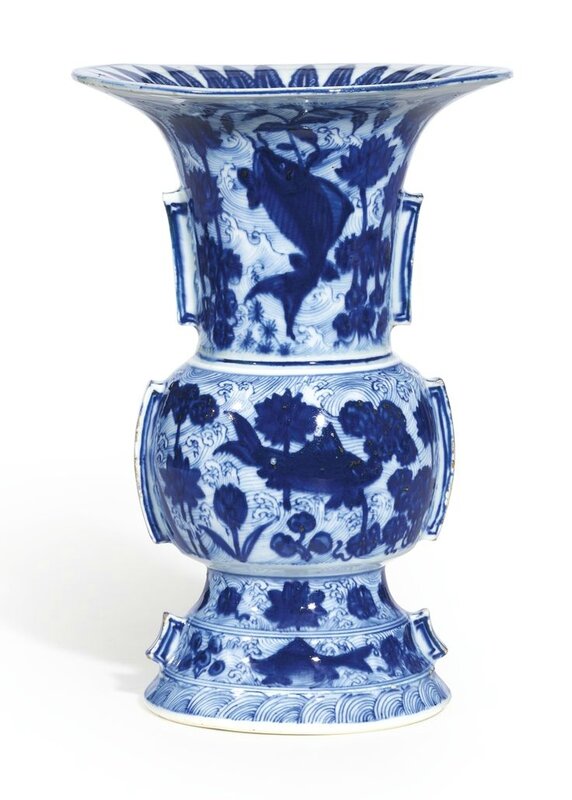A very rare blue and white 'Carp and Lotus' vase, zun, Ming dynasty, Jiajing period (1522-1566)
Lot 3665. A very rare blue and white 'Carp and Lotus' vase, zun, Ming dynasty, Jiajing period (1522-1566); 21.5 cm., 8 1/2 in. Estimate 2,000,000 — 3,000,000 HKD (233,438 - 350,157 EUR). Unsold. Photo Sotheby's.
the well-proportioned bronze-form body set with vertical flanges on opposite sides, the bulbous mid-section painted in deep, vibrant tones of underglaze blue with a carp swimming amidst lotus plants and water weeds reserved on a ground of finely picked out turbulent waves, the long trumpet-shaped neck similarly decorated with fish swimming up towards the rim, the stepped foot encircled with three bands of lotus, fish and rolling waves, the interior of the neck painted with slender overlapping leaves radiating towards the rim.
Provenance: A private New York collection, prior to 1950.
Imperial Oriental Art, New York, 1999.
Christie's New York, 21st March 2013, lot 1456.
Note: Vases of this type, vividly painted in cobalt blue with a lively design of carps swimming among waterweeds, are rare and only one other closely related example appears to be recorded, from the Qing court collection and still in Beijing, illustrated in The Complete Collection of Treasures in the Palace Museum. Blue and White Porcelain with Underglaze Red (II), Shanghai, 2000, pl. 92 (fig. 1). Porcelain wares decorated with this motif became more numerous during the Jiajing reign, as the emperor was a devout Daoist supporter and thus fond of designs filled with auspicious messages. The carp is associated with freedom, wealth and advancement in official life, and fish swimming in ponds creates the pun jin yu man tang (‘May your hall be filled with gold and jewel’). Reference to the increasing popularity of this design is found in the Tao shu [Book on ceramics] of the Jiangxi gazetteer (Jiangxi sheng da zhi), which mentions that on the 30th year of the Jiajing reign, corresponding to 1551, the Court dispatched an order for 200 blue and white vessels painted with fish (see the catalogue to the exhibition Two Rare Chinese Porcelain Fish Jars of the 14th and 16th Centuries, Eskenazi, London, 2002, p. 42).
Blue and white ‘fish pond’ vase, zun, Ming dynasty, Jiajing period, Qing Court collection, collection of Palace Museum, Beijing. After: The Complete Collection of Treasures in the Palace Museum. Blue and White Porcelain with Underglaze Red (II), Shanghai, 2000, pl. 92
Two Jiajing vases of this type, but painted on the interior with plantain leaves, in the Palace Museum, Beijing, are illustrated in The Complete Collection of Treasures in the Palace Museum, op. cit., pls. 91 and 93, together with two other examples attributed to the Zhengde reign (1506-21), pls. 50 and 51; and another in the National Palace Museum, Taipei, is published inPorcelain of the National Palace Museum. Blue and White Ware of the Ming Dynasty, Hong Kong, 1963, pl. 9. See also a vase of this form painted with dragons leaping over waves, attributed to the late 15th century, illustrated in Adrian Joseph, Ming Porcelains. Their Origins and Development, London, 1971, pl. 42; another from the collection of David Berg and now in the Arthur M. Sackler Museum, object number 1999.230.7; and a further vase decorated with a flower scroll, sold in these rooms, 8th April 2007, lot 523.
The form of this vase is based on archaic bronze wine vessels, gu, which were reproduced in porcelain from as early as the Song dynasty (960-1279). The imperial archaic bronze collection provided inspiration for the creation of numerous reinterpretations in ceramics according to the contemporary taste, as seen in this vase.
Sotheby's. Important Chinese Art, Hong Kong, 07 oct. 2015, 02:30 PM

/https%3A%2F%2Fprofilepics.canalblog.com%2Fprofilepics%2F1%2F0%2F100183.jpg)
/https%3A%2F%2Fstorage.canalblog.com%2F03%2F02%2F119589%2F96711876_o.jpg)
/https%3A%2F%2Fstorage.canalblog.com%2F11%2F31%2F119589%2F94773502_o.jpg)
/https%3A%2F%2Fstorage.canalblog.com%2F20%2F83%2F119589%2F94772815_o.jpg)
/https%3A%2F%2Fstorage.canalblog.com%2F26%2F72%2F119589%2F75604929_o.jpg)
/https%3A%2F%2Fstorage.canalblog.com%2F59%2F60%2F119589%2F26458628_o.jpg)




/image%2F1371349%2F20240416%2Fob_2a8420_437713933-1652609748842371-16764302136.jpg)
/image%2F1371349%2F20240414%2Fob_83ee65_2024-nyr-22642-0954-000-a-blue-and-whi.jpg)
/image%2F1371349%2F20240414%2Fob_15808c_2024-nyr-22642-0953-000-a-blue-and-whi.jpg)
/image%2F1371349%2F20240414%2Fob_e54295_2024-nyr-22642-0952-000-a-rare-blue-an.jpg)